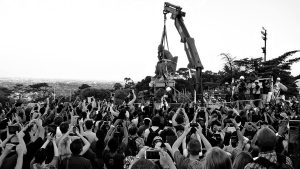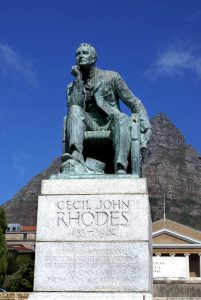Decolonizing Cape Town’s University : the “Rhodes must fall” student protest.

Decolonizing public spaces is a crucial initiative that aims to create a more inclusive environment accessible to all, regardless of their origin, gender, social class, religion, or other personal characteristics. It’s about tackling the historical inequalities and discriminations that have permeated public spaces. This post will examine the aspect of revising historical narratives, which is a fundamental part of this process.
“Rhodes Must Fall” is a remarkable movement in this regard, which was unleashed at the University of Cape Town in 2015. Students mobilized to have the statue of Cecil Rhodes, a symbol of colonialism, removed from the campus entrance. This movement reflects a broader movement to decolonize knowledge and public spaces.
The question now arises: what does the removal of the Rhodes statue mean for the decolonization process at the University of Cape Town? Let’s explore it.
First of all, Who is Rhodes?

Cecil Rhodes was an emblematic figure of nineteenth-century British imperialism, as evidenced by the fact that the colonies of Northern Rhodesia and Southern Rhodesia, which encompass present-day Zimbabwe and Zambia, were named in recognition of the role he played in their colonization. Rhodes’ political involvement in Africa was marked by ruthless imperialism and blatant racism towards the indigenous population. In a speech in 1887, referring to black Africans in the Cape Colony, he declared that the indigenous population “must be treated like children and deprived of the right to vote”.
He left a big sum of money to Oxford and many other institutions, including the University of Cape Town upon his death which funded the Rhodes Scholarship, a scholarship that to this day remains very prestigious and brings people to Oxford from all over the world.
His statue was placed at Cape Town University in 1934 in gratitude for the legacy of land he left to the university. On the plinth are inscribed a few lines from Rudyard Kipling’s imperial hymn “A Song of the Cities” (1893): “I dream my dream across rock, heath and pine/ From Empire to North. Ay, one land/ From Lion’s Head to Line”.
Why is the presence of his statue problematic?
Most of the controversies generated by the movement have revolved around the figure of Cecil Rhodes, but Rhodes himself is not really at the center of its objectives. What is at issue is an ethic that gives space and even pre-eminence to this figure and is reluctant to question Rhodes’s legacy. This legacy includes not only Rhodes’ financial legacies and their educational spin-offs, such as the Rhodes scholarships, but also the vision embodied in his will, which called for:
“The establishment, promotion and development of a Secret Society, the true aim and object whereof shall be for the extension of British rule throughout the world, the perfecting of a system of emigration from the United Kingdom, and of colonization by British subjects of all lands where the means of livelihood are attainable by energy, labor and enterprise, and especially the occupation by British settlers of the entire Continent of Africa …”
According to a student, placing the statue at the heart of “Africa’s largest university” was highly symbolic depicting a mass murderer who exploited black labor and seized land from indigenous people. In his opinion, it reinforced the exclusion of black students from the university and underlined the colonial architectural ideals deeply rooted in the education system, perpetuated by Rhodes. Its existence erased black history and constituted a form of violence against black students, workers, and staff.
“For black students and staff arriving at the university, the statue was a constant reminder of how and for whom the university was designed.”
What is the real meaning of Rhodes must fall ?
 The demonstration, which initially called for the removal of the Rhodes statue, broadened to include the legacy of colonialism and institutional racism at the University of Cape Town, as well as the call for the decolonization of higher education:
The demonstration, which initially called for the removal of the Rhodes statue, broadened to include the legacy of colonialism and institutional racism at the University of Cape Town, as well as the call for the decolonization of higher education:
“The chief focus of this movement is to create avenues for REAL transformation that students and staff alike have been calling for.”
In addition to the removal of the statue, the demonstrators had several long-term objectives. Decolonization was the main objective, the movement sought to challenge the colonial legacy embedded in the architecture, curriculum, and ethos of the university. They called for a transformation that recognizes and respects indigenous knowledge, cultures, and histories. The demonstrators also called for the promotion of African academics, authors, and researchers as part of the university curriculum. The aim was to combat the historical marginalization of African knowledge and views. Acknowledging historical injustices was another crucial facet of their movement, the students stressed the need to recognize past injustices, notably slavery, colonization, and apartheid. The aim was not only to recognize historical wrongs but also to work actively to repair them. They stressed the importance of creating an inclusive environment, where students, regardless of their racial or cultural background, have a sense of belonging. They stressed the need for diverse representation in academic staff, programmed content, and institutional policies.
Beyond the university’s confines, the movement became a significant force in the broader struggle for social justice in South Africa, by challenging symbols of oppression, the demonstrators contributed to a broader conversation about racial equality and social transformation. They did much more than just take down a statue; they resonated as a powerful call for a society that embraces inclusion, diversity of perspectives and true social justice, while actively addressing historical wrongs.
The ‘Rhodes Must Fall’ movement, although initiated at the University of Cape Town in South Africa, quickly spread beyond the borders of its place of origin to become an international phenomenon. It not only triggered the proliferation of student movements in South Africa but also led to the formation of the #RMF at Oxford University and similar movements at universities in the United States. The images of students determined to decolonize their university space by removing the statue of Cecil Rhodes captured the world’s attention. Stories of their struggle for inclusivity, diversity and social justice made the rounds of the international media, generating widespread support and global solidarity.
Leave a comment
You must be logged in to post a comment.